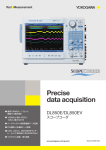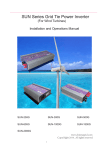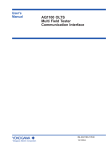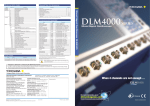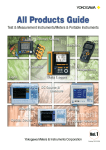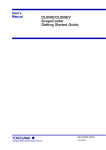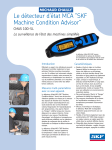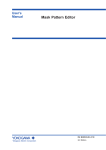Download Bulletin FG400-01EN FG400 Series Arbitrary
Transcript
How can you replicate real world signals? Precisely •0.01 μHz to 30 MHz, 20 Vp-p, 1 or 2 channels •Intuitive operation with a 3.5” LCD screen FG400 Series Arbitrary/Function Generator •Synchronize up to 6 units to provide up to 12 output channels •A variety of sweeps and modulations Bulletin FG400-01EN Features and benefits FG400 Series Features and benefits Easily generate basic, application specific and arbitrary waveforms. The FG400 Arbitrary/Function Generator provides a wide variety of waveforms as standard and generates signals simply and easily. There are one channel (FG410) and two channel (FG420) models. As the output channels are isolated, an FG400 can also be used in the development of floating circuits. (up to 42 V) Basic waveforms Sine Advanced functions DC 0.01 μHz to 30 MHz Sweep & Modulation ±10 V/open Square Burst Frequency sweep Setting items start/stop frequency, time, mode (continuous, single, gated single), function (one-way/shuttle, linear/ log) Auto Oscillation and stop are automatically repeated with the respectively specified wave number. PWM Setting items carrier duty, peak duty deviation Output duty the range of carrier duty ±peak duty deviation Trigger Oscillation with the specified wave number is done each time a trigger is received. AM Setting items carrier amplitude, modulation depth Output amp. the range of amp./2 × (1 ±mod. Depth/100) Gate Oscillation is done in integer cycles or half cycles while the gate is on. 0.01 μHz to 15 MHz, variable duty Pulse 0.01 μHz to 15 MHz, variable leading/trailing edge time Ramp 0.01 μHz to 5 MHz, variable symmetry 2 3 For trouble shooting Arbitrary waveforms (16 bits amplitude resolution) of up to 512 K words per waveform can be generated. 128 waveforms with a total size of 4 M words can be saved to the internal non-volatile memory. Waveforms can be selected from the displayed list. Waveforms can be created in the FG400 or with the editor software. The list of arbitrary waveforms Editing screen in the FG400 Editing screen of the editor software Acquire signal noise in the field, and then recreate it in the lab The FG400 can generate signals as arbitrary waveforms that have been acquired by measuring instruments. Trouble shooting is made easier as the FG400 can generate waveforms that are difficult to reproduce. For example noise that only occurs on site. With the XviewerLITE software (freeware), waveform (binary data) that is acquired using a YOKOGAWA DL850E or DLM4000 can be analyzed on the PC to find the abnormal waveform. This abnormal part can then be clipped, saved and generated using the FG400. [Application] Clipping the abnormal signal, then adding it to the normal signal Connect the clipped abnormal signal output of channel 2 to the additional input terminal of channel 1, and then press the Manual trigger key. The abnormal signal is added to the normal pulse waveform that is set on channel 1. Generation Acquisition addition Features and benefits FG400 Series Features and benefits Application-specific waveforms are also standard 4 Parameter-Variable Waveforms In some cases engineers need application-specific waveforms like those needed to evaluate the response characteristics of mechanical/ electrical circuits and to emulate power supply circuits. The FG400 provides 25 different types of waveform as standard. As the parameters of application-specific waveforms can be changed like those of basic waveforms, waveforms are quicker and easier to generate. Waveform name • Variable Parameters 1 Unbalanced sine 2 • First-half amplitude • Second-half amplitude 6 CF controlled sine 4 • Crest factor Conduction angle controlled sine 5 Multi-cycle sine 7 Gaussian pulse 12 Sin(x)/x 17 On-phase controlled sine 8 Lorentz pulse 13 Exponential rise 18 • Complete-on phase • On-slope time Off-phase controlled sine 9 Haversine 14 Exponential fall 19 • Off-phase • Off-slope time • Half value of width • Number of zero crossings • Number of steps 10 Half-sine pulse 15 Second order LPF step response 20 • On-phase • Number of chattering • On-state time • Off-state time • Width • Time constant Chattering-on sine • Width • Time constant Oscillation surge • Oscillation frequency • Damping time constant • Trailing time constant 22 Pulse surge • Rising time • Duration time 23 Trapezoid with offset • Leading delay • Rising-slope width • Upper base width • Falling-slope width • Offset 24 Half-sine edge pulse • Leading edge time • Trailing edge time • Duty Chattering-off sine • Off-phase • Number of chattering • On-state time • Off-state time Trapezoid pulse • Slope width • Upper base width Damped oscillation • Oscillation frequency • Damping time constant • LPF natural frequency • LPF Q 21 Staircase Sine • Conduction angle • Standard deviation 16 3 • Clip rate • Number of cycles • Start phase 11 Clipped sine 25 Bottom referenced ramp • Symmetry 5 Manually program waveform patterns Sequence function Sequences of different waveform patterns can be generated by programming the parameters. Complex sequences can be easily created using the “Sequence Edit Software”. Available parameters include: waveform, frequency, phase, amplitude, DC offset, square wave duty, step time, hold operation, jump destination, number of jumps, step stop phase, branch operation, step termination control, step sync code output Step Waveform Frequency Offset Sweep 1 Sine 1 kHz 0V — 2 Sine 1 kHz 1.5 V — 3 Sine 1 kHz 3V — 4 DC — 0V ON When 2 channels are linked (FG420 only) In the FG420 the two output channels can be linked. In this mode, both output signals vary when either channel is adjusted. • Independent: Independent setting • 2- phase: Holds the same frequency amplitude • Constant frequency difference: Holds the frequency difference as a constant value • Constant frequency ratio: Holds the frequency ratio as a constant value frequency DC offset Example of the differential output • Differential output: Same frequency, amplitude, and DC offset. Reverse phase waveform When you need more than 2 channels By synchronizing multiple FG410 and FG420s, a generator of up to 12 phases (using six FG420s) can be created. The phase of each channel is synchronized to the master unit and can be individually adjusted. Greater accuracy and stability The FG400 has an external input terminal to increase frequency accuracy and stability by using a frequency reference with better accuracy than the built-in reference (for example, a rubidium frequency standard). Master unit 10 MHz REF IN REF OUT Slave unit 10 MHz REF IN Use of external T divider reference possible Slave unit REF OUT 10 MHz REF IN Slave unit REF OUT 10 MHz REF IN 50 Ω termination resistor T divider Connection method 1 (up to 6 units) Master unit 10 MHz REF IN REF OUT Slave unit 10 MHz REF IN REF OUT REF OUT Slave unit 10 MHz REF IN Use of external reference possible Connection method 2 (up to 4 units) REF OUT Input/output terminal and Specification of FG400 FG400 Series Input/output terminal FG410 (1 ch) 6 5 1 2 3 6 7 8 9 7 8 9 4 FG420 (2 ch) 4 13 3 1 CH1 I/O terminals 2 10 12 5 6 11 Common I/O terminals CH2 I/O terminals 1 Waveform output 5 External 10 MHz frequency reference input 10 Waveform output 2 Sync/sub-output 6 Frequency reference output 11 Sync/sub-output 3 external modulation/addition input 7 Multi-I/O connector 12 external modulation/addition input 4 external trigger input 8 GPIB connector 13 external trigger input 9 USB connector Specification of FG400 Output and Oscillation Modes Number of channels FG410: 1 channel Sync/sub output FG420: 2 channels Output waveforms Sine, square, pulse, ramp, parameter-variable waveform, noise (Gaussian distribution), DC, arbitrary waveform Oscillation modes Continuous, modulation, sweep, burst, sequence Output voltage Sync signals: TTL level Internal modulation signal:−3 V to +3 V/open Sweep X drive: 0 V to +3 V/open Sine wave Amplitude frequency characteristics*1 Frequency Oscillation mode Continuous, modulation, Sweep (Continuous, Single-Shot) Sine 0.01 μHz to 30 MHz Sweep (Gated Single-Shot), Burst Sequence 0.01 μHz to10 MHz 0.01 μHz to10MHz 0.01 μHz to10MHz Square 0.01 μHz to 15 MHz 0.01 μHz to10 MHz Pulse 0.01 μHz to 15 MHz 0.01 μHz to10 MHz 0.5 Vp-p to 2 Vp-p/50 Ω 2 Vp-p to 10 Vp-p/50 Ω −60 dBc or lower −60 dBc or lower 1 MHz to 10 MHz −50 dBc or lower −43 dBc or lower 10 MHz to 30 MHz −40 dBc or lower −30 dBc or lower 0.01 μHz to5 MHz*2 Parameter-variable waveform 0.01 μHz to 5 MHz 0.01 μHz to5 MHz*2 Frequency setting invalid Arbitrary 0.01 μHz to 5 MHz Frequency setting resolution 0.01 μHz Frequency accuracy*1 ±(3 ppm of setting + 2 pHz), Aging rate*1 ±1 ppm/year Phase setting range −1800.000° to +1800.000° Output impedance *1 Non-harmonic spurious*1 Fixed to 26 MHz equivalent bandwidth DC DC offset Harmonic spurious 0.2% or less (0.5 Vp-p to 10 Vp-p/50 Ω) 1 MHz or lower 0.01 μHz to 5 MHz Output Characteristics Amplitude 10 Hz to 20 kHz: not usable Ramp Noise Total harmonic distortion*1 100 kHz or lower: ±0.1 dB 100 kHz to 5 MHz: ±0.15 dB 5 MHz to 20 MHz: ±0.3 dB 20 MHz to 30 MHz:±0.5 dB (±0.8 dB at 2.8 Vp-p/50 Ω or higher) (50 mVp-p to 10 Vp-p/50 Ω, reference frequency 1 kHz) Setting range 0 Vp-p to 20 Vp-p/open, 0 Vp-p to 10 Vp-p/50 Ω AC+DC ≤ ±10 V/open Setting resolution 999.9 mVp-p or lower 4 digits or 0.1 mVp-p 1 Vp-p or higher 5 digits or 1 mVp-p Accuracy*1 *4 ±(1% of amplitude setting [Vp-p] + 2 mVp-p)/open Setting units Vp-p, Vpk, Vrms, dBV, dBm Resolution Approx. 14 bits (36 mVp-p/open or higher) Setting range Resolution Accuracy*1 ±( | 1% of DC offset setting [V] | + 5 mV + 0.5% of amplitude setting [Vp-p])/open (Sine, 10 MHz or lower, 20ºC to 30 ºC) Square wave Duty Normal range Extended range 1 MHz or lower −60 dBc or lower 1 MHz to 10 MHz −50 dBc or lower 10 MHz to 30 MHz −45 dBc or lower 0.0100% to 99.9900% Upper limit (%): 100 − frequency (Hz) / 300,000 Lower limit (%): frequency (Hz) / 300,000 Jitter: 300 ps rms or less typ. 0.0000% to 100.0000% Jitter: 2.5 ns rms or less typ. Rising/falling time*1 17 ns or less Overshoot 5% or less typ. Pulse wave Pulse width (0.5 Vp-p to 10 Vp-p/50 Ω) Duty setting range: Time setting range: 0.0170% to 99.9830% 25.50 ns to 99.9830 Ms Leading edge time, trailing edge time Setting range 15.0 ns to 58.8 Ms (3 digits or 0.1 ns resolution) Leading/trailing edge time independently settable Minimum setting value Largest of either 0.01% of period or 15 ns ±10 V/open, ±5 V/50 Ω Overshoot 5% or less typ. ±499.9 mV or lower 4 digits or 0.1 mV ±0.5 V or higher 5 digits or 1 mV Jitter 500 ps rms or less typ. (10 kHz or higher) 2.5 ns rms or less typ. (under 10 kHz) 50 Ω, unbalanced Ramp wave Symmetry setting range 0.00% to 100.00% Parameter-variable waveform Waveform group Waveform name Steady sine group Unbalanced sine, Clipped sine, CF controlled sine, Conduction angle controlled sine, Staircase sine, Multi-cycle sine Transient sine group On-phase controlled sine, Off-phase controlled sine, Chatteringon sine, Chatteringoff sine Equivalent setting, same operation Set two channels at the same time. Pulse group Gaussian pulse, Lorentz pulse, Haversine, Half-sine pulse, Trapezoid pulse, Sin(x)/x Transient response group Exponential rise, Exponential fall, Second order LPF step response, Damped oscillation Frequency difference setting range 0.00 μHz to less than 30 MHz (0.01 μHz resolution) CH2 frequency − CH1 frequency Surge group Oscillation surge, Pulse surge Frequency ratio N:M setting range 1 to 9,999,999 (for each of N and M) N:M = CH2 frequency:CH1 frequency Other waveform group Trapezoid with offset, Half-sine edge pulse, Bottom referenced ramp Phase synchronization Automatically executed during channel mode switching Arbitrary waveform Waveform length 7 2-channel ganged operation (FG420 only) Channel modes Independent, 2-phase (holds same frequency), Constant frequency difference, Constant frequency ratio, Differential output (Same frequency, amplitude, and DC offset. Reverse phase waveform.) 4 K to 512 K words (2n, n = 12 to 19) or 2 to 10,000 control points (linear interpolation between control points) Total waveform saving capacity Up to 128 waveforms or 4 M words (combined total for channels 1 and 2) saved to non-volatile memory Amplitude resolution 16 bits Sampling rate 120 MS/s Modulation Type FM Carrier waveform: Peak deviation: FSK Carrier waveform: Hop frequency: PM Carrier waveform: Peak deviation: PSK Standard waveform other than noise, pulse wave and DC, and arbitrary waveform Within settable carrier waveform frequency range Standard waveform other than noise and DC, and arbitrary waveform 0.000° to 180.000° Deviation: Standard waveform other than noise and DC, and arbitrary waveform −1800.000° to +1800.000° Carrier waveform: Modulation depth: Standard waveform other than DC, and arbitrary waveform 0.0% to 100.0% DC offset Carrier waveform: Peak deviation: Standard waveform and arbitrary waveform 0 V to 10 V/open PWM Carrier waveform: Square wave, pulse wave Peak deviation Square wave: Normal variable duty range 0.0000% to 49.9900% Extended variable duty range 0.0000% to 50.0000% Pulse wave: 0.0000% to 49.9000% AM Carrier waveform: Standard waveform other than noise, pulse wave and DC, and arbitrary waveform 0.00 μHz to less than 15 MHz Internal modulation waveform Other than FSK, PSK:Sine wave, square wave (50% duty), triangular wave (50% symmetry), rising ramp wave, falling ramp wave, noise, arbitrary wave FSK, PSK: Square wave (50% duty) Internal modulation frequency Other than FSK, PSK:0.1 mHz to 100 kHz (5 digits or 0.1 mHz) FSK. PSK: 0.1 mHz to 1 MHz (5 digits or 0.1 mHz) Sweep Sweep types Frequency, phase, amplitude, DC offset, duty Sweep functions One-way (ramp waveform shape), shuttle (triangular waveform shape) (selectable) Linear, log (frequency sweep only) (selectable) Sweep range setting Start value and stop value specification or Center value and span value specification Sweep time setting range 0.1 ms to 10,000 s (4 digits or 0.1 ms) Sweep mode Continuous, single-shot, gated single-shot (selectable) During gated single-shot, oscillation occurs only during sweep execution Trigger source Internal, external (selectable) Internal trigger oscillator Period setting range: 100.0 μs to 10,000 s (5 digits or 0.1 μs) Stop level setting Specification of signal level while oscillation is stopped during gated single-shot sweep Setting range: −100.00% to +100.00% of amplitude full scale or off Sweep I/O Sweep sync/marker output, Sweep X drive output, Sweep external control input, Sweep external trigger input Burst Burst mode Auto burst, Trigger burst, Gate, Triggered gate (Gate oscillation switched on/off by gate upon trigger) Other functions External 10 MHz Voltage/waveform frequency reference input for synchronizing multiple FG410, FG420 units. External addition input Function to add the external signal to the waveform output signal. 1 cycle, 0.5 cycles (selectable) Phase setting range −1800.000° to +1800.000° Stop level Specification of signal level when oscillation is stopped. Setting range: −100.00% to +100.00% of amplitude full scale or off When the stop level is set to off, stop occurs at the set oscillation start/stop phase. Trigger source Internal, external (selectable). Manual trigger possible Addition gain ×2/×10/off selectable The maximum output voltage range is fixed to 4 Vp-p (×2) or 20 Vp-p (×10). Voltage/waveform −1 V to +1 V, DC to 10 MHz (−3 dB) Input impedance 10 kΩ, unbalanced Used for sweep and sequence control. Synchronization of multiple units Sync operation is possible. Up to 6 units can be connected with BNC cables in the form of master/slave connections, using the frequency reference output and external 10 MHz frequency reference input. User-Defined Unit Sets and displays the value in any unit, using a specified conversion expression. Setting target Frequency, period, amplitude, DC offset, phase, and duty Conversion expression [(Setting target value) + n] × m, or [log10 (setting target value) + n] × m Specification of conversion expression and values of n and m Unit character string Up to 4 characters Setting saving capacity 10 settings (saved to non-volatile memory) Interface GPIB, USBTMC (SCPI-1999, IEEE-488.2) General Characteristics Display 3.5 inch TFT color LCD Input/output ground - The signal grounds for waveform output, sync/sub output and external modulation/ addition input are insulated from the housing. (42 Vpk max. These signal grounds are common within the same channel.) - The signal ground for the external 10 MHz frequency reference input is insulated from the housing. (42 Vpk max.) - Each signal ground for CH1, CH2 and external 10 MHz frequency reference input is independent. Power supply AC 100 V to 230 V ±10% (250 V max.) 50 Hz/60 Hz ±2 Hz Power consumption FG410 50 VA or less FG420 75 VA or less Operating temperature/ 0ºC to +40ºC, 5%RH to 85%RH humidity range (Absolute humidity of 1 g/m3 to 25 g/m3, no condensation) Weight Approx. 2.1 kg (main unit excluding accessories) Dimensions 216 (W) × 88 (H) × 332 (D) mm (excluding protrusions) Sequence Editor Editing functions • Initializes, copies, pastes, inserts, and deletes steps • Saves and reads sequence data to/from a file. • Sequence can be edited without connecting the device. Displaying functions • Editing screen: Lists parameters for each step. • Sequence view screen: Graphs changes of up to five parameters. Transferring functions • Transfers and reads sequence data to/from the device. • Transfers to the device the arbitrary waveform used in the sequence. Device control functions • Output on/off • Starts, stops and holds the sequence. • Can monitor the execution status of sequence. Operating environment • Windows XP/7 • USB interface • NI-VISA from National Instruments USB driver (required) Arbitrary Waveform Editor Editing functions • Generation (standard waveform and a mathematical expression) • Interpolation (straight line, spline, and continuous spline) • Math operation (addition, subtraction, multiplication, and division of waveform) • Contraction and extension (vertical and horizontal directions) • Cuts, copies, and pastes some part of waveform • Undo function • Saves and reads arbitrary waveform data to/from a file. • Waveforms can be edited without connecting the device. • Zoom in/out • Scroll • Display unit (coordinates) selectable • Cursor (A, B) TTL level Input impedance 10 kΩ (pulled up to +3.3 V), unbalanced Transfer function • Transfers and reads arbitrary waveform data to/from the device. Device control function • Major parameter setting Panel key operation Operating environment * Same as the operating environment for the Sequence Editor. Trigger delay 0.00 μs to 100.00 s (5 digits or 0.01 μs) Latent delay of 0.55 μs, Only valid for trigger burst External trigger input Sequence Step control parameters 1 Vp-p/50 Ω square wave, 10 MHz Display functions Internal trigger oscillator 1.0 μs to 1,000 s (5 digits or 0.1 μs) Manual trigger Voltage/waveform Multi input/output Number of Mark/Space 0.5 cycles to 999,999.5 cycles, in 0.5-cycle units Oscillation stop unit during gate 0.5 Vp-p to 5 Vp-p, Sine wave or square wave Frequency reference output Step time, hold operation, jump destination, number of jumps, step stop phase, branch operation, step termination control, step sync code output Intra-step channel parameters Waveform, frequency, phase, amplitude, DC offset, square wave duty Usable waveforms - Sine wave, square wave, noise, DC, and arbitrary wave - Ramp wave and parameter-variable waveform can be used through saving as arbitrary waveforms. Maximum number of usable waveforms 128 Number of saved sequences 10 sequences (saved to non-volatile memory) Number of steps Maximum of 255 steps per sequence Step time 0.1 ms to 1,000 s (4 digits or 0.01 ms) In-step operations Constant, keep, linear interpolation (except waveform switching) Jump count 1 to 999 or infinite Branch operation Upon branch input, branching to specified destination step XviewerLITE Functions *3 Operating environment • Reads the waveform data. (WVF/WDF format) • Displays the waveform. (main, zoom, history and X-Y) • Saves the waveform data to ascii and text. • Displays the waveform parameter value. • Cursor • Windows XP/Vista/7 • USB interface (USB driver) •Unless otherwise specified, the value assumes the following conditions: continuous oscillation, load of 50 Ω, DC offset setting of 0 V, auto range, waveform amplitude range of ±FS, external addition turned off; the AC voltage is rms value. *1: Guaranteed numerical value. Other numerical values are nominal or typcal (typ.) values. *2: Used after converted into arbitrary waveform. *3: It can be downloaded from the web site. *4: Condition: 1 kHz sine, amplitude setting of 20 mVp-p/open or higher. Model Related Products Suffix Code Description FG410 Arbitrary/Function Generator: 1-Channel, 30 MHz FG420 ScopeCorder DL850E/DL850EV Arbitrary/Function Generator: 2-Channel, 30 MHz Power cord -D -F -R -Q -H -N UL/CSA standard, PSE VDE standard AS standard BS standard GB standard NBR standard •17 types of plug-in modules (voltage, temperature, strain, acceleration, frequency, logic, CAN, LIN) •High-speed (up to 100 MS/s), High resolution (up to 16-bit), Isolated (up to 1 kV) Standard Accessories; Power cord (1 set), User’s manuals and application software (1 set) Model/ parts number Product Description 705928 Multi input/output cable For sweep/sequence control 751537-E2 Rack mount kit Inch rack mounting (for 1 unit) 751537-J2 Rack mount kit Millimeter rack mounting (for 1 unit) 751538-E2 Rack mount kit Inch rack mounting (for 2 units) 751538-J2 Rack mount kit Millimeter rack mounting (for 2 units) •128-CH voltage/temperature, 128-bit logic measurement Mixed Signal Oscilloscope DLM4000 • 8 analog channels/7 analog channels + 8-bit logic Unit: mm • 350 MHz, 500 MHz analog bandwidth • Large 12.1-inch LCD display 99 Mixed Signal Oscilloscope DLM2000 11 88 • Long memory: Up to 125 M points • Lightweight and compact 216 • 200 MHz, 350 MHz, 500 MHz analog bandwidth • 4 analog channels/3 analog channels + 8-bit logic • Long memory: Up to 125 M points Notice 10 332 Before operating the product, read the user’s manual thoroughly for proper and safe operation. 8 If this product is for use with a system requiring safeguards that directly involve personnel safety, please contact the Yokogawa offices. 350 This is a Class A instrument based on Emission standards EN61326-1, and is designed for an industrial environment. Operation of this equipment in a residential area may cause radio interference, in which case users will be responsible for any interference which they cause. Any company’s names and product names mentioned in this document are trade names, trademarks or registered trademarks of their respective companies. The User's Manuals of this product are provided by CD-ROM. YOKOGAWA METERS & INSTRUMENTS CORPORATION Global Sales Dept. / Phone: +81-42-534-1413 Fax: +81-42-534-1426 Email: [email protected] http://tmi.yokogawa.com YOKOGAWA CORPORATION OF AMERICA YOKOGAWA EUROPE B.V. YOKOGAWA ENGINEERING ASIA PTE. LTD. Phone: (1)-770-253-7000 Phone: (31)-88-4641000 Phone: (65)-62419933 Subject to change without notice. ©2014, Yokogawa Meters & Instruments Corporation Fax: (1 )-770 -254- 0928 Fax: (31)-88-4641111 Fax: (65)-62412606 (Ed:01/b) Printed in Japan, 403(KP)









